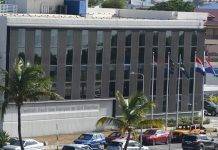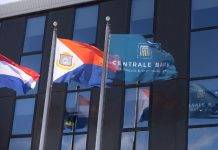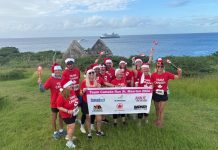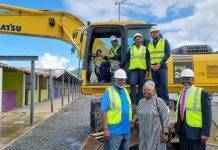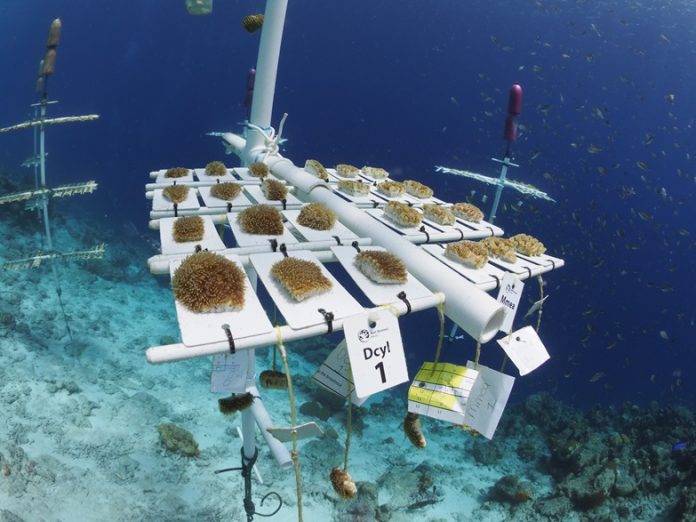Each of the six islands—Aruba, Bonaire, Curaçao, Saba, St. Eustatius, and St. Maarten—has taken unique and proactive measures to address the challenges facing their reefs. The restoration efforts by local nature conservation organizations were presented during the recent Dutch Caribbean Nature Alliance (DCNA) Reef Restoration Workshop and are critical in ensuring the health and longevity of these underwater treasures for many years to come.
Aruba: Building a Future for Coral Reefs
Aruba’s reef restoration efforts are spearheaded by the Aruba Conservation Foundation (ACF), which has been actively working to revive and sustain the island’s coral ecosystems. One of the key initiatives is the new “Turning the Tide” project, funded by RESEMBID and partnered with Wageningen University & Research. The project is using artificial reefs placed across 3 different seabed locations located within the Parke Marino Aruba. The artificial reefs recreate the three–dimensional structure which will hopefully help restore key herbivorous species. ACF is also supported by the work of ScubbleBubbles and University of Aruba, who are maintaining coral nurseries and conducting regular beach and reef clean ups. There is also exciting new work with their partnership with the Metabolic Foundation to map the sea floor.
Bonaire: A Global Leader in Reef Preservation
STINAPA Bonaire has implemented one of the Caribbean’s most successful marine protected area (MPA) systems, which has been crucial in preserving its coral reefs. Furthermore, Reef Renewal Foundation Bonaire (RRFB) has been at the forefront of restoration efforts, establishing coral nurseries that are among the most advanced in the region. In addition to outplanting thousands of corals each year, RRFB enhances the genetic diversity of vulnerable species via their coral breeding program. Additional partnerships with partners such as STINAPA Bonaire, Wageningen University and Research, Florida State University and Rasster Lab has further elevated local nature conservation organization’s ability to integrate science-based monitoring into its management efforts, making it a leader in the field of coral conservation. New innovative ways to improve local fish populations is being explored by Blijdorp (RoffaReefs) and this project is co-funded by WWF-NL. A new ReefGrazers project aims to restore the reefs by reintroducing native algae-eating species. This collaborative effort involves Van Hall Larenstein University of Applied Sciences, Wageningen University, Wageningen Marine Research, the Public Entity Saba, STINAPA Bonaire, STENAPA and Saba Conservation Foundation, and WWF-Netherlands.
Curaçao: Innovative Approaches to Reef Restoration
Curaçao’s reef restoration activities are driven by a combination of scientific research and community involvement. The Carmabi Foundation, in collaboration with the Curaçao Marine Park, Reef Renewal Curaçao and Branch Coral Foundation, has pioneered several innovative techniques in coral restoration, including microfragmentation and the use of substrates designed to enhance coral growth. These techniques have been developed in partnership with international experts, including researchers from SECORE International and the University of Miami. Curaçao’s restoration efforts also involve local dive shops like Ocean Encounters and Dive Division, which contribute to outplanting efforts and monitoring the health of the reefs. Public education and outreach programs, supported by local nature conservation organizations and the University of Curaçao, are essential in fostering a culture of marine stewardship among residents and visitors.
Saba: Protecting the “Unspoiled Queen”
The Saba Conservation Foundation manages the Saba Marine Park and the Saba Bank, which have been instrumental in maintaining the integrity of the island’s marine ecosystems. Coral restoration initiatives on Saba are supported by partnerships with universities such as Wageningen University & Research and Van Hall Larenstein University of Applied Sciences, and the ongoing Dutch government’s Nature and Environmental Policy Plan (NEPP) reef restoration project. These efforts focus on establishing coral nurseries to propagate threatened coral species, as well as cutting edge research on herbivore restoration, for example the Diadema II project working to understand recovery and restoration the Diadema antillarum populations. The SCF also collaborates with local dive operators, such as SeaSaba, to involve the community in reef monitoring and restoration activities, ensuring that Saba’s reefs remain pristine and vibrant.
St. Eustatius: Reviving Coral Reefs Through Community Engagement
St. Eustatius has been actively involved in reef restoration through the work of the St. Eustatius National Parks Foundation (STENAPA). STENAPA’s previous past coral restoration project focused on cultivating and outplanting corals. STENAPA is now focusing on herbivore restoration with its NEPP Coral Reef Restoration project. Statia has experienced a drop from 25% hard coral coverage to less than 2.5% in the past 20 years. Reefs are now dominated by macroalgae which compete with coral for space on the reef and preventing young coral larvae from settling. Bringing key herbivore populations such as the long spined sea urchin Diadema antillarum back to the reef is paramount to provide space for coral to settle and grow. This restoration project is conducted in partnership with restoration practitioners and researchers and will in the future include other complementary herbivores. Currently STENAPA has changed focus with the ongoing NEPP Coral Reef Restoration Project to the cultivation and release of key herbivores such as Diadema antillarium. These herbivores graze on and subsequently reduce algal cover on reefs, clearing crucial space for settling coral recruits. Coral cover needs to improve on reefs after a drastic drop from 25% to 1% in the 20 years between 1999 and 2001. Community engagement is a cornerstone of Statia’s restoration strategy, with local schools and volunteers learning about reef conservation activities. Educational programs organized by STENAPA aim to build local capacity for long-term reef management and foster a deep connection between the community and their marine environment.
St. Maarten: Collaborative Efforts for Reef Recovery
In St. Maarten, the Nature Foundation St. Maarten plays a pivotal role in coral reef restoration, collaborating with local and international partners to enhance their efforts. The foundation has established coral nurseries around the island, with a particular focus on restoring populations of elkhorn and staghorn corals. These efforts are supported by partnerships with the St. Maarten Nature Reserve, EPIC (Environmental Protection in the Caribbean), and academic institutions such as the University of St. Martin and the University of the Virgin Islands. The Nature Foundation also works closely with local businesses, including dive centers like Dive Sint Maarten, to involve them in coral outplanting and monitoring efforts. Public education and outreach campaigns, supported by these partnerships, aim to increase awareness of the importance of coral reefs and encourage sustainable practices among residents and tourists.
A United Front for Reef Restoration
Coral reefs face several serious threats, ranging from climate change, invasive species, pollution to overfishing. Protecting these reefs must go beyond just restoration, as tackling these issues alongside ongoing efforts will be essential to fully protect these vital ecosystems. During the DCNA workshop, it was clear that there is a need to improve interisland collaboration and knowledge sharing. Working together we can leverage the power of our local experts to elevate projects across the islands. DCNA is currently exploring next steps to facilitate this further, for example, the set up the Conservation and Restoration of Key Habitat Program which will span all six islands and will include coral reef habitats.
This workshop was funded by the Ministry of Agriculture, Fisheries, Food Security and Nature (LVVN) and supported by the Dutch Postcode Lottery.

